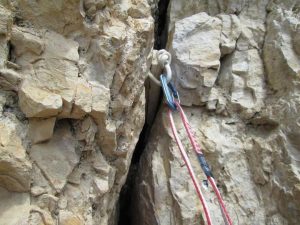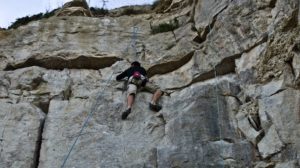Cracks are natural weaknesses in rock surfaces, formed by fracturing, uplift, and erosion. Many climbing routes follow cracks and systems of cracks because they are easier to protect with gear like cams and nuts than blank faces, which are usually protected with permanent bolts placed in drilled holes in the rock. From the very beginnings of rock climbing in the early part of the twentieth century, climbers learned to climb cracks to exploit these natural lines up cliff faces.
Crack Sizes
Climbers usually describe cracks by the appendage used to climb them, such as a hand crack, fist crack, or finger crack. Wider cracks are called off-width cracks and chimneys. Climbers refer to the width of a crack as its “size.” How you climb or jam a crack depends on its size relative to your body.
Difficulty Ratings Depend on Hand Size
The difficulty of jamming a crack depends on a climber’s finger and hand sizes. The difficulty rating of a crack climb is body dependent, usually determined by the size of a climber’s hands. A man’s hand crack is usually an off-width crack for a woman who has smaller hands. For example, Supercrack, one of the most famous crack climbs at Utah’s Indian Creek Canyon, is a ladder for anyone with big hands, while those with small hands have to use fist jams or resort to more strenuous off-width crack techniques.
Rating the Difficulty of Crack Climbs
When you look at the difficulty rating of a crack, don’t be fooled by the grade—it may be easier or harder for you than its accepted rating. Hand and fist cracks are usually the easiest cracks to climb. They are often rated between 5.8 and 5.10. Off-widths, even easy ones, are hard and strenuous to climb. Off-widths require a lot of technique and patience. Watch out for those 5.8 and 5.9 off-width cracks—they can feel really hard! Finger cracks are the hardest cracks to climb since they’re usually strenuous and require perfect jamming techniques. Sustained finger cracks are usually rated 5.12 and 5.13. Again remember—crack ratings depend on your hand and finger sizes.
How to Crack Climb? Improve your Jamming Skills
If you learn to climb at an indoor gym, it’s hard to learn how to climb cracks. While some gyms have practice cracks, crack climbing is a skill that is best learned outside on real rock.
Crack Climbing is Learned
Crack climbing, unlike face climbing, is not a natural technique but rather a learned technique. Crack climbing is counter-intuitive. When you are face climbing, you keep in balance and move upward by finding handholds and footholds. When you jam cracks, you have to “read” the crack and then figure out how to wedge your fingers or hands in it and where to place your feet. The technique to surmount a section of crack can sometimes be puzzling and experience goes a long way toward jamming a crack with an economy of effort.
Practice Jamming at a Local Cliff
Practice and improve your jamming skills at your local cliff. Set up top-ropes on various sized cracks and do laps on them. Practice all the different jams if possible—finger jams, hand jams, fist jams, off-width technique, and chimney moves. Figure out how to wedge your fingers and hands in cracks and see what body positions work best. Experiment with your foot placements. After you jam a crack to your top-rope anchor, down climb it to improve your crack technique.
Footwork is Key
When we begin to crack climb, all we think about is jamming our hands and fingers into cracks. It’s our hands that usually determine both the difficulty and the techniques used to jam a crack. We think of finger cracks, hand cracks, and fist cracks. But the truth is that your footwork—how you place, weight, and use your feet when you are jamming a crack—is just as important as your hand and finger jams.
Solid Foot Jams Keep You Solid
How you use your feet is super important for efficient and successful crack climbing. You can learn and practice all the perfect hand jams, finger locks, and fist jams that you need but if you do not know how to use your feet when you are crack climbing then you are going to struggle, get pumped out, and probably fall. Crack climbs, even perfect hand crack splitters like Supercrack, can be desperate if your footwork isn’t solid.
Think Feet First
Every time you jam a crack, think feet first. Let your feet support your weight as much as possible and those jams won’t hurt so much and you will be moving your hands up quicker and more securely than if your feet are floundering. Let your feet support your body weight whenever possible rather than your jams. Use good footwork to propel you up the crack.
Your Crack Climbing Shoes
Before honing your crack footwork, consider your rock shoes. A lot of sport climbing shoes are not well-suited for crack climbing. Sure they are comfortable, have pointy toes, and are flexible but they are usually not built for the rigors of jamming. A good all-around rock shoe is best for crack climbing. Make sure the shoe has lots of rubber on the rand around the toes and the heel because you will be using those parts of the shoe for friction on rock; is somewhat stiff so that your foot doesn’t have to work as hard when it’s jammed in a crack; and offers some ankle protection. Try to wear a rock shoe that allows your toes to lie flat rather than being cramped and contorted in the toe box.
Ankle Protection is Essential
It can be hard to find a rock shoe that covers the ankles. Instead, most sport shoes are cut below the ankle. If you jam many cracks, your ankles are going to get cut, bleed, and be a mess. And if you go jamming again tomorrow, you will reopen those old wounds. If you wear a low-cut shoe, tape your ankles with athletic tape or wear socks.
How to Slot Your Foot in the Crack
The best cracks to practice your basic foot jams are on hand and fist cracks since they are roughly the same width as your foot. For your first foot jam, slot your foot into the hand-size crack with the big toe facing up and the little toe facing down. Slide your shoe in the crack up to the arch of your foot. Keep your knee cocked out sideways rather than in line with the crack.
Torque Your Knee and Use Your Waist
Now torque or straighten your knee and leg inward toward the crack. This motion twists the rock shoe and locks your foot in place in the crack. Bend at your waist to raise your legs up instead of bending your arms. This motion might feel insecure and unnatural at first but with a little practice, you will realize that it’s actually secure since as you step upward, your weight transfers onto your feet.
Weight Your Feet and Push With Your Legs
Next, step up on your first foot jam and place your second foot above it in the crack. Weight your feet and push with your legs. Pull your hips close to the wall as you push up, which keeps your weight on your feet rather than your arms. Practice this movement as you jam the crack and try to keep your hand jams loose in the crack, relying on them more for balance and to hold you in place rather than pulling your body weight upward. As you jam the hand crack, imagine the crack as a ladder with invisible rungs, let each foot jam become one of those rungs that supports your weight and upward movement.
Practice Foot Jams for Crack Mastery
This is the basic nuts-and-bolts technique for crack footwork. Find a good hand crack and do top-rope practice laps on it to hone and master your jamming techniques. Find the right distance to place your top foot above your bottom one. Remember that small steps take less energy than big ones.
Avoid Getting Your Foot Stuck
As you practice, learn how far you have to slot your foot in the crack to be secure. You want to find a balance between having your foot too far inside of the crack and having it grab only the outer lip of the crack. The farther into the crack that you slot your foot, the more difficulties you might have removed it from its secure placement. Every experienced crack climber can tell you tales about stuck shoes in cracks. I was once leading a crack pitch on The Diamond on Longs Peak in Rocky Mountain National Park when I jammed my foot too far inside a hand crack. The shoe was royally stuck and my foot would not budge. I had to get a good nut above me, get a tight rope from my belayer far below, and then untie the shoe, remove my foot, and then wrangle the stuck shoe out of the crack. I was ultra-careful with my foot jams after that incident.
Use Footholds Outside the Crack
As you practice foot jams, learn to look for face holds outside of the crack that you can use for footholds. To move fast and efficiently on a long crack climb, you will often jam cracks with only one foot in the crack. The other foot finds crystals and edges outside the crack for balance and for pushing off. If you keep both feet in the crack all the time, it can often be strenuous and cause you to barn-door, that is you will feel off-balance and have to fight from swinging to the side.













